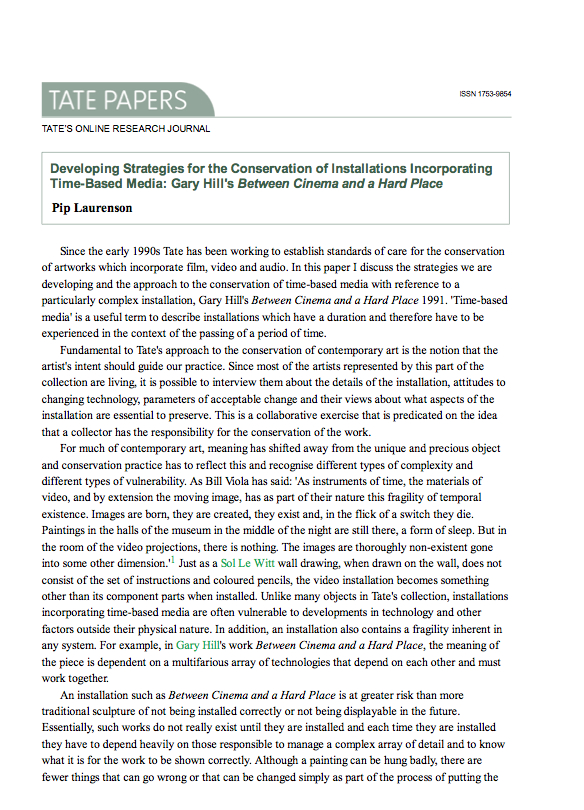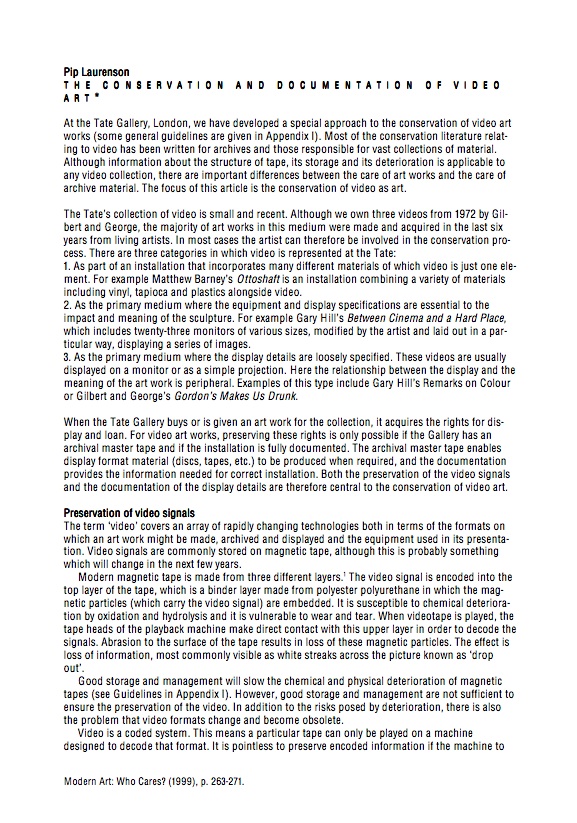Resource Guide Homepage
Resource Guide Homepage
Behavior & Environment
In addition to documenting the individual components of an installation, a work's behavior needs to be documented to preserve it accurately over time. Behavior is not only the way in which the installation behaves or acts, but also the way the installation operates under a particular set of conditions determined by the artist. The ideal method of documenting behavior begins with the artist, if possible. An artist's interview or questionnaire is becoming increasingly common practice in collecting institutions.
Questions to ask the artist include:
·What is the installation's production history?
·What are the original formats and what are the display formats (if there's a difference)?
·What is the essential essence of the work? Provide an artist's statement.
·What are its important behaviors and essential "look and feel?"
·What equipment is utilized? Has any of the equipment been modified by the artist?
·Is the equipment integral to the work?
·How does the work exist in a given space? Describe the environment, including lighting
conditions and sound levels. Provide dimensions of the installation site(s).
·Describe audience or user response.
·Is change inevitable?
·If so, what change is acceptable?
This information will be critical if the work ever needs to be reinterpreted, in the event of obsolescence of the original media, for example, or if it is reinstalled in another space.
Because installations are site-specific, it is useful to document how an audience responds or interacts with a work at a specific site. For instance, interviews with visitors, still photographs or video of the installation, or summaries of particular interactions or exchanges with the work using diagrams or a brief narrative are all helpful elements. (Keep in mind that this kind of documentation adds its own preservation needs).
Other forms of documentation are important as well. Collect ancillary materials related to the work, such as blueprints or room specifications, tech drawings, exhibition guides, or press books.
For additional information on documenting media installations, an excellent case study, and a collection of questions to ask artists, see Pip Laurenson's "Developing Strategies for the Conservation of Installations Incorporating Time-Based Media: Gary Hill's 'Between Cinema and a Hard Place'" and "The Conservation and Documentation of Video Art Both articles are available to view at the bottom of this page.
For more information on the documentation strategy, review concepts behind Rhizome's ArtBase Artist Questionnaire and the Guggenheim Museum's Variable Media Questionnaire. (Note that you need to be a member of Rhizome and the Variable Media Network for access to these online questionnaires.)
With an item-level record created for the work-its physical materials and its "look and feel"-a clearer picture of preservation needs emerges and it is now possible to begin estimating costs for preserving the installation. This information is also critical when approaching funders, who invariably want a clear sense of the project's scope.
Developing Strategies for the Conservation of Installations Incorporating Time-Based Media: Gary Hill's "Between Cinema and a Hard Place"
Since the early 1990s Tate has been working to establish standards of care for the conservation of artworks which incorporate film, video and audio. In this paper I discuss the strategies we are developing and the approach to the conservation of time-based media with reference to a particularly complex installation, Gary Hill's Between Cinema and a Hard Place 1991.
The Conservation and Documentation of Video Art
At the Tate Gallery, London, we have developed a special approach to the conservation of video art works (some general guidelines are given in Appendix I). Most of the conservation literature relat- ing to video has been written for archives and those responsible for vast collections of material. Although information about the structure of tape, its storage and its deterioration is applicable to any video collection, there are important differences between the care of art works and the care of archive material. The focus of this article is the conservation of video as art.

